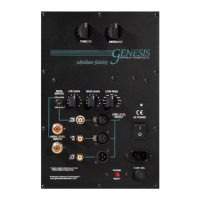ver 1.3
16
1616
16
~ÄëçäìíÉ=ÑáÇÉäáíó
Sidewalls. Because the speaker is a dipole it is less sensitive to the
sidewalls. However, as a rule of thumb it is a good idea to keep the
speaker as far away from the sidewalls as is practical. In some
rooms, it may be helpful to add some damping material or diffuser
panels to the point of first reflection. This is a point on the sidewalls
between the listener and the loudspeaker. It is where the sound
from the loudspeaker first hits the sidewall, then bounces to the
listener. This reflection is undesirable because it is slightly delayed
from the original sound. This point on the sidewall can be easily
determined with the help of a second person and a mirror.
Sitting in your listening position, have an assistant hold a mirror up
on the sidewall. Move the mirror until you can see the tweeter. This
is the point of first reflection. A diffuser (see your audio dealer), an
absorptive material or even a piece of furniture can help break up
this point of first reflection.
Rear wall. In many cases it will be unnecessary to do anything with
the wall behind your listening position. However, you may want to
experiment with diffusers or absorbers behind you for best sound.
Absorption behind the listener is usually beneficial.
4.5 Mastering the Refinements of the system
Fine tuning an audio system is an art that will take time and patience. It
can be one of the more rewarding learning experiences you will have in
the pursuit of music and its enjoyment.
One of the best pieces of advice we can offer is that you take advantage
of your ear's ability to identify similarities in sound. This ability is useful in
fine-tuning your system because, if every recording you listen to has a
similarity of sound (too much or too little of a certain frequency for
instance), then you can be fairly certain that you have yet to perfect your
set-up. Keep at it, and remember to enjoy your music as you work on
perfecting your set-up.
If you have any questions, feel free to contact us at Genesis. Our
website is the first place that you can look to for more information, but
you are welcome to either send us an email, or just give us a call!

